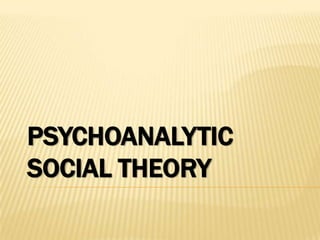Horney ppt
- 2. BIOGRAPHY OF KAREN HORNEY ï Karen Danielsen Horney (âhorn-eyeâ) ï Born near Hamburg, Germany, on September 15, 1885 ï One of the first women in that country admitted to medical school. ï She died in 1952 at age 67.
- 3. INTRODUCTION TO PSYCHOANALYTIC SOCIAL THEORY ï Horneyâs writings deal mostly with what she called neuroses and neurotic personalities, her theories are also appropriate to normal development. ï she placed far more emphasis on social factors.
- 4. HORNEY AND FREUD COMPARED ï She held that Freudâs explanations result in a pessimistic view of humanity. ï Horney criticized Freudian theory on at least three accounts: 1. its rigidity toward new ideas, 2. objected to Freudâs idea on feminine psychology 3.its overemphasis on biology and the pleasure principle.
- 5. THE IMPORTANCE OF CHILDHOOD EXPERIENCES ï Neurotic conflict stems largely from childhood traumas, most of which are traced to a lack of genuine love.
- 6. ï Children who do not receive genuine affection feel threatened and adopt rigid behavioral patterns in an attempt to gain love.
- 7. BASIC HOSTILITY AND BASIC ANXIETY ï parents often neglect, dominate, reject, or overindulge their children, conditions that lead to the childâs feelings of basic hostility toward parents.
- 8. ï If children repress basic hostility, they will develop feelings of insecurity and a pervasive sense of apprehension called basic anxiety.
- 9. 4 GENERAL WAYS THAT PEOPLE CAN PROTECT THEMSELVES FROM BASIC ANXIETY : ï 1. affection, ï 2. submissiveness, ï 3. power or prestige ï 4. withdrawal.
- 10. NEUROTIC NEEDS ï Horney identified 10 neurotic needs that mark neurotic people in their attempt to reduce basic anxiety:
- 11. 1. needs for affection and approval, 2. needs for a partner 3. needs to restrict oneâs life within narrow borders, 4. needs for power, 5. needs to exploit others,
- 12. 6. needs for social recognition or prestige, 7. needs for personal admiration, 8. needs for ambition and personal achievement, 9. needs for self-sufficiency and independence, 10. needs for perfection and unassailability
- 13. NEUROTIC TRENDS ï Later, Horney grouped these 10 neurotic needs into three basic neurotic trends: ï 1. moving toward people ï 2.moving against people ï 3. moving away from people
- 14. ï Each of these trends can apply to both normal and neurotic individuals in their attempt to solve basic conflict. However, whereas neurotic people are compelled to follow only one neurotic trend, normal individuals are sufficiently flexible to adopt all three.
- 15. ï People who move neurotically toward others adopt a compliant attitude in order to protect themselves against feelings of helplessness;
- 16. ï people who move against others do so through aggressive behaviors that protect them against perceived hostility from others;
- 17. ï people who move away from others do so in a detached manner that protects them against feelings of isolation by appearing arrogant and aloof.

















